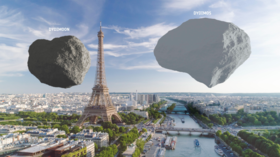Asteroids v Eiffel Tower? ESA gets cash boost, shares breathtaking mockup of space rocks at famous landmark

The ESA has been handed a huge cash injection to explore the Didymos binary asteroid with a view to protecting Earth. To mark the windfall the space agency has shared a unique photo of rogue rocks looming over the Eiffel tower.
The EU granted the ESA its largest funding boost in 25 years to fund the Hera mission, which is planned to be mankind’s first mission to a binary asteroid system (with Japan already having studied the single asteroid Ryugu).
Two-asteroid binary systems make up roughly 15 percent of all asteroids, so if we are to adequately prepare our planetary defenses, we’ll need to be prepared to tackle them in an emergency. To put things into even more perspective, the ESA shared a remarkable image showing the scale of the threat posed by such binary asteroids.
Europe’s space ministers have approved ESA’s #HeraMission! It’ll be going to a very strange place – a 780-m #asteroid with its own 160-m moon orbiting 1.2 km away. Here’s what the #DidymosAsteroid pair would look like beside the #EiffelTower#Space19plushttps://t.co/vEcmuPbfQwpic.twitter.com/e7kcFDkrpI
— ESA Technology (@ESA_Tech) November 29, 2019
The double spacecraft collaboration between the ESA and NASA is due to launch in 2024. The Didymos asteroid binary is made up of a mountain-sized main asteroid, with a gigantic 780 meter (2,560 feet) diameter, which is orbited by a 160 meter-diameter moon, called the ‘Didymoon’ which is roughly the same size as the Great Pyramid of Giza.
NASA will carry out a kinetic impact on this Didymoon after the agency’s Double Asteroid Redirection Test, or DART, which is expected to collide with Didymos in 2022.
Also on rt.com ‘Insurance policy for planet Earth’: Space agencies to smash spacecraft into asteroid at over 14,000 mphHera will follow-up with a closer, more detailed post-impact survey in one of the largest planetary defence experiments humanity has ever conducted. It’s hoped the mission will allow us to better understand both the composition and structure of asteroids with a view to deterring them should they pose a threat to our planet. If all goes to plan, the spacecraft will reach Didymos in 2026.
If the mission is successful, the Didymoon will become the first object in our solar system to have its orbit intentionally shifted by human effort.
Think your friends would be interested? Share this story!














